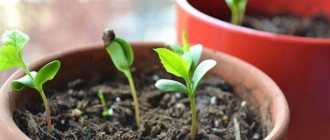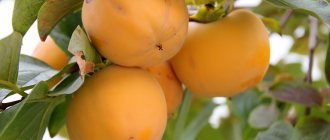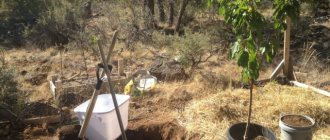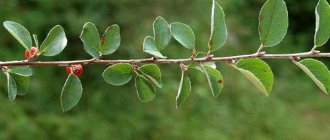Let's take a closer look at all the stages of caring for an avocado plant at home, photos of which are given below:
Photo of how an avocado blooms:
Features of care after purchase
It is best to place an avocado near a north window
, the plant
is light-loving
and tolerates partial shade well.
The flower must be protected from direct rays to avoid burns.
During the winter season
the flower may experience
a lack of light and moisture
; at twelve degrees the plant may completely shed its leaves, but it must be taken into account that they will appear again in the spring.
In winter, it is recommended to place fluorescent lamps or phytolamps next to the avocado. As the flower grows, it is recommended to monitor its appearance; brown leaves indicate a lack of moisture, yellow leaves indicate an excess of moisture.
.
Seasonal care calendar
The avocado care calendar coincides with the calendar of other plants.
Trimming plant stem segments
Avocados are large in size, so periodically the plant needs to form a crown
.
It is important to preserve the leaves, which prevent the formation of sunburn.
In mature plants, it is recommended to cut off infected, damaged, densely intertwined branches
, as well as the upper parts of vertical shoots, which will contribute to the formation of a more branched crown. It is recommended to be careful during the pruning process, since the branches of the plant are fragile, and the buds and shoots are susceptible to damage.
NOTE!
Did you know that black avocados exist? The variety is called . By the way, Avocado of this variety is one of the best and most popular.
Should you pinch an avocado?
How to pinch an avocado? There should be 3-4 shoots left on the trunk; after reaching a length of twenty centimeters, the tops are pinched, thus forming branches of the next level. It is recommended to do the first pinching over the eighth leaf; after activating branching, they should be pinched over the fifth or sixth leaf. With this approach, in two to three years the tree will occupy most of the room.
Bloom
At home, flowering conditions, and even more so fruiting, are quite difficult to achieve.
. Although avocados can self-pollinate, a good harvest is only achievable through cross-pollination. It is worth noting that even under natural conditions, not all flowers produce fruits.
During flowering, if this does happen, a large number of flowers appear on the crown of the plant; some gardeners manage to carry out cross-pollination with a brush. It is recommended to do this in the morning, when the sun has risen; on cloudy days, additional lighting is required.
Lighting
Avocados need good lighting
, placing it under direct rays is not recommended; in autumn and winter, it is recommended to additionally illuminate the plant with a special phyto-lamp.
Temperature
The optimal temperature for the plant is eighteen degrees.
, its level should not be lower than sixteen degrees.
Air humidity
humidity is very important for its normal development.
, the area around the tree must be sprayed regularly, being careful not to get it on the leaves.
A good solution would be to install the plant in a tray with damp moss or expanded clay.
Watering
The plant needs water, but it is not recommended to do this very often; the soil should have time to dry out between waterings. To avoid flooding of the substrate, it is recommended to lay drainage at the bottom of the container
. The soil for the plant should be sufficiently moist and loose throughout the year.
Priming
When choosing soil, preference should be given to fertile mixtures
, good drainage plays an important role.
The flower does not tolerate substrates with high acidity; the substrate must be neutral
. You can prepare soil for avocados at home yourself; to do this, you need to mix humus, soil and sand in equal proportions, and add lime.
For avocados, a citrus substrate is perfect; the soil should be loose. If replanting was not carried out for some reason, in order to prevent salinization of the substrate, the top layer of soil must be replaced and the remaining soil must be shed with water.
Fertilizers
It is recommended to fertilize the plant after it is one year old; the frequency of feeding is 4 times a year.
.
Mineral mixtures are excellent for fertilizing plants.
, as well as
fertilizers for citrus fruits
.
It is recommended to add nitrogen to the soil of mature plants in June and December; if yellow leaves are present, it is recommended to include zinc and iron in the mixture.
Height
In the first three months, the plant can reach fifty centimeters in height; to improve conditions, it is recommended to maintain optimal conditions for development. Subsequently, the speed slows down, new leaves begin to appear, measuring thirty-five centimeters from the base.
IMPORTANT!
Avocados can reach two and a half meters, so it is recommended to pinch them regularly to stimulate the appearance of side shoots.
Transfer
How to replant an avocado? The tree grows quite quickly, so it needs to be replanted periodically
, the procedure is recommended to be carried out in the spring. Young plants need to be replanted annually; adults can be replanted once every three years.
It is recommended to replant an avocado at home for the first time when the plant reaches ten to fifteen centimeters in height. The dimensions of the container each time must be larger than the previous one. The composition of the substrate is identical to the soil when planting avocado seeds. It must be taken into account that the plant can reach large sizes, so containers must be of appropriate size.
Avocado, like all plants, helps purify the air in the room and has other beneficial properties, which you can learn about.
Avocados can be grown at home from the seed. The flower is characterized by rapid growth, moisture-loving properties, can reach 2.5 meters in height, and requires regular replanting and pinching. To bear fruit, it requires cross-pollination, blooms very rarely, and can be grown in open ground.
Crown formation
An indoor avocado grown from a seed quickly stretches upward and takes on a not entirely attractive appearance. To give the plant a bushy shape and form a lush crown, you should regularly pinch it. After the transplanted tree reaches a height of at least 15-20 cm, you can pinch the crown. This will allow the top to form. Next year you can already pinch out the overgrown side branches (for better branching to the sides).
Fertilizers can be applied only a year after transplantation. This is usually done several times in the spring or early summer. If yellowness appears on the leaves, the crown of the plant should be additionally sprayed with iron chelate.
Avocado loves fresh air very much, so if possible, place the pot with the plant outside on warm days.
Useful video
We invite you to watch a video with personal experience of caring for avocados at home:
In the fall, just for fun, I planted an avocado seed (this way I have already managed to get an indoor lemon). The experiment was a success - the seed has sprouted and is gradually growing leaves. Tell me how to care for avocados at home? Does it need bright light or can the flowerpot be placed on a north window?
Recently, lovers of exotic plants have become increasingly common among flower growers. Thanks to them, some cultures living in the wild have safely migrated to our homes and are doing quite well there. Take the avocado, for example, a tall evergreen tree with original green fruits native to distant Mexico. Lovers of indoor plants liked its large bright green leaves so much that the exotic Mexican began to be used for decorative purposes for landscaping indoors.
In nature, avocado grows up to 30 m in height, but indoors it grows in the form of a small tree (no more than 2.5 m), and does not bear fruit.
Growing an avocado is not very difficult. If you create conditions that are as close to natural as possible and properly care for it, you can get a very beautiful and compact plant.
Caring for avocados at home consists of a set of measures, namely:
- choosing a suitable location for the bush (with the necessary lighting and air temperature);
- proper watering and fertilizing;
- formative pruning;
- regular transplant.
Features of indoor avocado
An avocado tree grown indoors has some peculiarities. Here are just a few of them:
- If an adult plant that grows in natural conditions can reach a height of up to 20 meters, then a home tree most often does not grow higher than three meters.
- The fruits of homemade avocados grow, much less ripen, extremely rarely. If you are lucky enough to wait for the first fruits, and this may not happen earlier than in 5 years, then indoor avocado fruits will taste significantly different from those grown in the natural environment.
- The indoor plant has a unique ability to purify the air, and also, thanks to its exotic and voluminous crown, to create a comfortable environment in the room.
How to prune and when to replant?
In indoor conditions, avocados often stretch, so formative pruning is an important step in caring for them. To do this in the spring, you need to pinch or cut off the shoots after the 8th leaf to stimulate branching. Repeat the procedure all summer on each young branch.
Features of growing indoor avocado - video
You can learn how to grow avocados by reading the recommendations of experienced gardeners. Compliance with all the rules and recommendations, proper care and patience will help you grow an exotic tree at home that will decorate your interior.
An avocado plant at home can be grown up to 2-2.5 meters; it will be more of a decorative decoration than a fruit-bearing crop. A relative of the laurel, the avocado has glossy, varnished leaves that are dark green in color. The fruit of this exotic tree looks like a pear, the color of which is varied - from green to purple.
The crown should be shaped like a shrub, then the evergreen tropical plant will look more attractive, otherwise it will look like a weakly leafy tree with an elongated trunk. You can grow avocados at home, you just need to know that when growing indoors, the plant may not bloom and will not bear fruit.
Growing avocados indoors is attractive because this exotic tree is easy to grow from a seed, so you don’t have to look for ready-made seedlings on sale. Its advantage is the unique feature of purifying the air in the house. To understand how to grow an avocado, understand the intricacies of the process; it is not complicated, the plant is not capricious, the main problem is to achieve flowering and fruit appearance. In apartment conditions, avocados rarely bloom and bear fruit, so exotic lovers, setting themselves the goal of achieving a harvest, must strictly adhere to the following rules:
- a certain microclimate is created in the room, the air must be humidified daily;
- the plant needs abundant watering in summer, and moderate watering in the cold season;
- mandatory fertilizing; in the warm season, complex fertilizers are required, in the fall - combined mineral compositions based on iron and zinc;
- good lighting, bright, but not hot, sunlight;
- in winter - creation of additional lighting;
- regular pruning, crown formation, pinching;
- annual replanting into a larger container;
- If possible, place the pot with the plant in the open air in the summer, for example, in the country, under trees.
Plant lovers want to see how an avocado blooms at home, what fruits can be grown on a tree, but this is not always possible. By correctly carrying out all agrotechnical measures, you can see flowering in 5-7 years; to speed up this process you need to get vaccinated. A 3-year-old grafted plant can bloom for the first time, at which time its crown is covered with a large number of white or yellowish flowers. Having achieved flowering, it is necessary to cross-pollinate the inflorescences artificially, using a brush, to grow fruit, do this several times.
An avocado grown indoors can produce a harvest once it reaches a height of two meters and is provided with vaccinations (ready-made grafted seedlings are sold in specialized stores). It is fashionable to grow avocado fruits at home in about five percent of cases, and the remaining 95% of plants do not bloom and do not produce a harvest, remaining only a decorative decoration for the interior.
To grow an avocado and make it bear fruit, you need to stimulate it; this can be done by pinching the top parts of the branches. But even the most careful and proper care, the creation of the necessary conditions and the required microclimate in the room, cannot guarantee that the plant will begin to bloom and fruit will appear. If you're lucky, you'll reap the harvest in five to seven years.
The task of how to germinate an avocado from a seed at home does not require much effort; you just need to choose the right fruit from which you extract it. A fruit that is not ripe or overripe is not worth buying; its seed is not suitable for planting. Remove the seed carefully, without damaging its integrity, then rinse thoroughly under running water, saturating the surface with moisture. It is possible to germinate a seed in the ground or in water, the first option will take up to 30-40 days, the second method will give results faster.
When planting in the ground, we choose the most common soil intended for home flowers. We lower the seed into the ground with the blunt end down, water it moderately (after ensuring drainage) and place the container in a well-lit place. The soil should not dry out; keep it constantly moist, but do not overdo it. To germinate in water, insert three toothpicks into the seed, which will allow you to hold it suspended above the container, 1/3 of the way, plunging the blunt tip into the water. After the roots appear (at least 2-3 cm in length), plant the seed in the soil.
To plant a seed in the ground, choose a small container. Growing avocados from seed at home in the first weeks consists of regular but moderate watering, lighting and good drainage. After 7-10 days, a sprout appears, reddish in color, which will begin to rapidly grow in height (provided that it is healthy). Intensive growth and development occurs over 3-3.5 months; during this period, its top should be pinched in order for the forcing of lateral branches to begin.
You need to choose a pot for growing avocados at home based on the size of the plant, giving preference to natural materials. Transplant the tree, which has reached a height of 12-15 cm, from the original planting pot into a larger container; if necessary, this procedure is repeated annually. A plant, being in cramped conditions, may lose bushiness, become faded and begin to lose foliage. An adult tree does not require such frequent replanting, since its root system slows down its growth.
The soil for growing avocados is not acidic or heavy; to grow a healthy plant, neutral soil, well loosened and nourished, is suitable. When buying soil in a store, you can choose soil “for citrus fruits.” To independently prepare the necessary soil mixture to grow avocados, take the following elements:
- 2 parts of garden soil;
- 2 parts sand;
- 2 parts organic matter, peat;
- 1/2 part of crushed expanded clay, polystyrene foam;
- 1 tbsp lime.
This soil is used when planting a seed or replanting a plant annually. Garden soil may contain harmful microbes, so the resulting mixture should be disinfected by pouring boiling water over it or keeping it in a preheated oven. Carry out this procedure a day before planting a seed or sprout. In order for the seed to “breathe” in the ground, and later water does not stagnate in the roots, you need good drainage, at least 1.5-2 cm.
To make an avocado tree at home look highly decorative and bushy, the top should be pinched. This procedure is carried out after the first 6-8 leaves appear on the plant; it will stimulate the appearance of lateral branches. Pinch out new shoots after 4-6 leaves. Pinching is best done in the spring; this will help the tree form a beautiful, lush crown within 1.5-2.5 years.
Caring for avocados at home is not difficult, but it must be constant, especially for young plants. Create the following comfortable conditions for the tree to grow it correctly:
- lighting (use artificial lighting if necessary, especially in autumn and winter), although this plant tolerates partial shade perfectly;
- temperature above room temperature in summer, at least +20° C – in winter, with less comfortable temperature conditions, leaf shedding is possible;
- regular watering, increased during the growing season, moderate in the autumn-winter;
- air humidity, this parameter is necessary to maintain the beauty of the plant; during the heating season, spray the tree with warm water more often;
- fertilizing with various complexes, this should be done in spring-summer and early autumn, later the plant does not need fertilizers;
- pruning is necessary to form a beautiful crown and decorative appearance.
In order to decide whether it is necessary to water the avocado again, dig your finger 4-5 cm into the soil; if you feel moisture, there is no need to water it. Use settled water, preferably its temperature should be 3-5° C degrees above room temperature. In summer, water more often, immediately after the top layer has dried; in the cold season, intensive watering is not required.
Avocado is a tropical plant and does not tolerate dry air; spray water around it often, avoiding getting it on the leaves. You can grow an avocado tree from a seed by placing the pot in a tray with either moss or well-soaked expanded clay, especially if you are leaving home for several days and cannot water the tree on time. When using this method, do not let the bottom of the pot touch the water.
Having learned all the details about how to properly grow an avocado, pay special attention to the feeding process. Caring for avocados at home requires the mandatory application of fertilizer to the soil; this should be done during the active period of plant development, that is, in spring and summer. The frequency of use of mineral, organic complexes or special compositions for citrus fruits is one to two weeks.
When thinking about how to grow an avocado at home, exotic lovers should know that if favorable conditions are created for it, it can have a height of up to 2-2.5 meters and have a lush, branched crown. Being an evergreen, decorative tree, it will decorate any room, and with special care and proper care, you will see it bloom and taste delicious fruits.
Copying information is permitted only with a direct and indexed link to the source
the best materials from WomanAdvice
Subscribe to receive the best articles on Facebook
#1 oleg73
Sent 08/21/2006 - 23:19
Even if you pinch him, he gives away one branch. I have now cut it to 5 cm from the seed (it was under a meter), it seems like 3 cm will fit, but I doubt that they will not dry out along the way. If one branch does grow, it will remain for the winter outside.
Pinch and trim are slightly different things.
It is certainly difficult to achieve other branches, but it is possible.
Well, we don’t have the problem of wintering either.
#2 Nick
Sent 07/05/2007 - 15:23
In short, after 3 years, no matter how I cut and pinched, I ended up with a skeleton with large burdocks at the ends of thin branches, which, moreover, sagged even in good lighting. I cut it, but it still doesn’t want to bush - the cut branches don’t seem to have dried out, but grow exclusively from above.
I looked at it, thought about it and left it in good hands. Well, if at least the trunk were beautiful, then even if it was bare, but otherwise the trunk is featureless, cannot be shaped in any way, and there are not enough leaves!
#3 tati
Sent 09.29.2007 - 19:14
It's probably better to plant 3 or more avocados at once. To make it more crowded
I have two avocado trees growing in one pot. When they were 3 months old (about 40cm high), a rabbit got to them and chewed them under the bone. Stumps of 2 cm remained. From which side shoots immediately began to grow, one on each plant. After waiting for them to grow 30 cm, I pinched the tops. A couple more branches came out. now he is 2 years old. A very cute bush. But the sun burned the leaves on the balcony
In the Welcome
to the question How to properly grow and care for avocados?
asked by the author Nadezhda Anokhina
the best answer is Avocado (Persea americana) can hardly be called attractive in appearance, the lumpy, wrinkled shell of the fruit resembles crocodile skin, for which in its homeland - South America - it is nicknamed “alligator pear”. Strictly speaking, this name applies only to fruits from Guatemala; other varieties of avocados (and there are about 400 of them now known) are distinguished by smoother skin.
Inside the fruit there is a large dense core, and it seems simply incredible that it can germinate, however, as they say, appearances are deceiving; there are practically no problems with avocado germination.
For planting, it is best to select the core of a ripe fruit, which should be soft to the touch. Carefully remove the pit from the fruit, rinse it in warm water and let it dry overnight. The thin outer shell of the kernel will crack as a result, making it easy to remove (but not necessary).
It is best to take a pot with a diameter of at least 15 cm; in this case, the young plant will not need to be replanted for a year, which will give it the opportunity to properly develop and strengthen. Fill the pot with soil, but not all the way to the top, and plant the core with the blunt end down so that a third of it is above the soil level. This is a very important condition; avocados require light for germination. Water the soil with warm water, cover the top with an inverted glass or plastic bag and place the pot in a warm, bright place, but away from direct sunlight. Make sure the soil does not dry out. The germination period can be from 3 weeks to three months, so be patient, all this time your pet is not inactive, but, unnoticed by you, is diligently busy forming the root system. The first external sign of germination is quite spectacular - the sharp tip of the kernel will burst in half, and soon a sprout will appear from the crack. Once it reaches a height of about 10cm, add soil to the pot so as to completely cover the cracked core, this will speed up the growth of the plant.
There is another way to sprout avocados. To do this, insert 3-4 pointed matches into the kernel prepared in the manner described above (about a third of the height of the kernel from the top), not deep, but just enough to secure them in the dense pulp. After this, take a small jar of water and place the kernel over it so that its lower part is immersed in water by about 1-1.5 cm. Observing germination in this case is much more interesting; you can see not only the development of the green top, but also root formation. As soon as the seedling grows, remove the matches and carefully plant it in a pot of soil, being careful not to damage the roots.
Being a native of the tropics, avocados require regular watering. Avocado grows well in any soil, but especially loves humus.
At first glance, it may seem that growing an avocado tree from a seed at home is difficult, if not completely impossible. But that's not true. Everyone can afford to grow this ornamental tree without much effort, and in the future enjoy its fruits. True, you need to know some secrets. We will reveal them for our readers in this publication.
Avocado seedling. © Jeffrey Schwartz
How to care for an avocado tree?
To grow an avocado tree at home, you need to provide it with careful care. This plant loves light, but will develop normally in partial shade. In summer, it should be shaded from the bright rays of the sun, and the best option would be to place a pot of avocado on a western window. The tree does not tolerate sudden temperature fluctuations, and in a draft it can lose all its leaves. The same can happen when the room temperature drops to +12ºС and below.
The street avocado tree is replanted once every three years. If you decide to leave the avocado tree outside in winter, then it must be carefully insulated using any covering material. When grown in a greenhouse, it must be provided with additional heating, and the trunks must be wrapped in foam rubber. It happens that a tree blooms in winter, but the buds cannot withstand the cold and fall off, although with the arrival of spring, flowering will occur on time.
How to pinch an avocado tree?
To make the avocado a real decoration of the room, you can initially plant three plants in one pot. As they grow, their flexible branches can be intertwined with each other in a pigtail. To form a lush, beautiful crown, the tree must be pinched. This is done after eight leaves appear on the stem. As a result, the side shoots of the plant will begin to grow, and as soon as they grow, their tops also need to be pinched. This is how you can get an adult avocado tree grown indoors.
How to water an avocado?
When growing avocados at home, you need to monitor the air humidity, which should be at least 70%. To maintain it, you can spray the plants with a spray bottle. In summer, an avocado tree in a pot should be watered generously; in winter, watering should be reduced. It is better to follow this rule: the warmer the air in the room, the more frequent and abundant the watering should be. This plant is especially sensitive to both drought and overwatering because its roots do not have small root hairs. During prolonged drought, the tree stops growing, sheds leaves and even fruits.
How to fertilize avocados?
When growing avocados at home, they are fed only during the period of active growth, in the spring and summer. Do this once every 2-3 weeks, using a special organic fertilizer for avocados or a balanced fertilizer for citrus fruits. In autumn and winter, the plant does not need supplements. Before fertilizing your home avocado tree, you should carefully study the instructions for using fertilizers.
How to shape an avocado tree?
For fast and uniform growth, a mature avocado tree must be pruned. It is better to do this in early spring or autumn, after harvesting. The work should be carried out very carefully, since the branches of the tree are brittle and can be easily damaged. The side shoots are cut off by about half, this should stimulate branching of the plant. On trees, all dry, damaged branches and those that grow into the middle of the tree are removed, thereby thickening its crown and preventing air exchange.
Avocado diseases and pests
The exotic avocado tree in the country and indoors can be affected by various pathogens and insect pests. Avocados that are grown in home conditions different from natural ones become especially vulnerable in this regard. The following diseases and pests are especially dangerous for this plant:
- Late blight
. The roots are affected first, then the trunk and bark of the tree. It is impossible to cure the plant; you just have to destroy it. - Powdery mildew
. A fungal disease affects the leaves and trunk of avocados. First, a plaque appears on the affected plant, and then yellow-green dried spots. Control measures: spray with fungicide. - Shield
. Settles on leaves and stems. To get rid of them, you need to wash the affected parts of the tree with a soapy solution. A large tree is treated with insecticides.
Sprouting an avocado seed
The avocado fruit must be peeled, pitted and sown on the same day. Usually the seed germination rate is 100%. There are three ways to plant a seed.
- The unpeeled seed can be planted directly into the ground, leaving a third on top. The blunt end must be in the soil. We leave the seed in this state and need to water it once a week.
- The uncleaned bone can be pierced in three places with toothpicks 3 mm deep, and then placed in water with the blunt end. The lower part should be in water, and the puncture sites should not be immersed in water.
- The peeled avocado pit should be placed in water, leaving a third on top. A cleaned seed germinates faster, and in this case you can observe how the root system and stem are formed.
Avocado seeds, germination in water.
© KVDP Germination of avocado seed in the ground. © skyseeker Avocado sprout from the seed. © Cayobo It is better to choose a large seed for planting, as it has more energy for growth. Water for soaking should be used at room temperature (23-25°C). You can add charcoal or activated carbon to the water, but this is not necessary, since the seed is unpretentious and will germinate well without these additives.
The seed may sprout in a week, or maybe in two months. It depends on the season. It is best to plant it in the spring, as it will germinate faster at this time.
Caring for a tree grown at home
Among the features of caring for homemade avocados, it is worth noting only:
- choosing the right temperature and light conditions, because the plant is southern by nature;
- frequent watering with water at room temperature;
- timely fertilization with minerals.
When watering, try not to over-moisten the soil. Holes should be made at the bottom of the pot to drain excess water. In summer, water an adult plant weekly, or even 2 times a week. But in winter, watering should be done less often - it will be enough to saturate the soil with moisture only after the top layer of soil has completely dried. Remember to spray your avocado greens frequently with a spray bottle.
An adult plant thrives in a well-lit place, but does not tolerate direct sunlight. Therefore, it is best to cover the pot with the tree from the bright sun.
Planting a seed in the ground
As soon as the sprout grows 3 cm, it can be planted in the ground. The soil must be loose and well-drained so that the seed can breathe. Avocados do not like stagnation of water in the roots, so drainage is required. You can take a small pot for planting; later, after a year, the plant can be replanted.
The drainage should be 2 cm high. It is necessary to make a small depression in the soil, plant a seed in it so that a third comes out of the ground, and then water it with ordinary settled water, preferably with a small amount of salts, preferably filtered.
Next, the pot needs to be placed in the brightest place in the room; it can be fertilized once a month or once every two weeks; any mineral fertilizer will do for this. In this case, the plant will grow and develop quickly.
If the tree is stretched due to lack of sunlight, then it needs to be pinched. To determine whether a plant requires watering, it is necessary to dig your finger into the soil two phalanges. If it is wet, there is no need to water it.
Avocado flowers. © Cayobo
To give the tree a more decorative look, you can sprout several avocado seeds, and then, while they are growing, weave a braid from the stems. In this case, the braid should not be very tight. It is imperative to leave gaps between the segments, because the trunk grows over time. Otherwise, the decorative effect of the plant will be lost. When there is a gap, the weave can be fixed due to the flexibility of the stem.
Starting from the third year of life, yellow-green flowers may appear on the tree. In order for the tree to start bearing fruit, it is advisable to have two or more avocado plants. This is necessary for cross-pollination of trees.
It is advisable to take the plant to the dacha in the summer and place it under the crowns of trees in a sunny place. Then the avocado will begin to bear fruit in the third year.
I've heard a lot about how easy it is to grow a beautiful, strong adult plant from the seed of an exotic fruit. For example, kiwi, lemon, dates, pomegranate, persimmon, and mango are planted. I wanted to grow avocados, but I had doubts - would it work?
Preparatory actions
Before you start germinating a plant, you should make sure that the seed will be removed from a truly ripe fruit. An indicator of the ripeness of an avocado is its external signs (dark skin, elastic flesh), as well as the ability to restore its shape after not too much pressure.
If you plan to grow a new plant from a seed, you should cut the fruit with extreme care. You need to make a not too deep cut around the avocado (no more than 1 cm), then using rotational movements, as if opening a jar, divide the fruit into 2 halves, in the middle of one of them there will be a seed. Using a dessert spoon, remove the bone and rinse under running water. When extracting the valuable center, try not to damage the brown shell covering the pit.
How to grow an avocado: from personal observations
This is not my first attempt to grow a tree from a seed or a seed; I managed to germinate a lemon before, I already wrote about this in the article “?”, the tree is still alive, it hasn’t grown big yet, but it doesn’t bear fruit, of course. For harvesting, you still need to graft the plants. It just grows here and pleases us with its green beauty.
The Internet is full of resources where they write, tell and show how to properly grow an avocado from a seed, and I have seen enough of such material. Once the theoretical part is mastered, it’s time to move on to practice.
The next two avocados were eaten in a healthy salad, the seeds were carefully separated. You need to rinse them a little to remove all the mucus from the surface of the pit, otherwise the water will quickly become cloudy, and the avocado can quickly rot without sprouting.
How well and quickly the process of “revival” will proceed, how quickly the seed will react to water, probably depends on the fruit itself. Several previous attempts to grow avocados were unsuccessful.
The bones were separated. They were washed, put into cups of water for germination, stood for weeks, or even months, and it was obvious that it would not be possible to grow avocados from such material. These bones were somehow too dense. always the same shape, similar to a heart.
Maybe this type, or they need more time. And I hurried them... Moreover, just by looking at the fruit when buying it, you can never immediately determine what shape the seed will be. It depends on your luck. I had oval shaped avocado pits hatching that looked like a dinosaur egg. There were no problems with them, even by their appearance it was always clear that new life was warming and awakening in them.
How to grow an avocado: procedure
There is an opinion that it will not be possible to grow an avocado beautifully; this plant has no aesthetic charm for home use. This still didn’t stop me; I wanted not a lonely sad tree to grow, but a beautifully formed palm tree from several sprouts.
Using the same principle, you can shape the trunk of an avocado.
I figured out in advance how to beautifully intertwine the trunks of young avocado shoots so that it would turn out just like that. They can be intertwined in different ways - in a braid of 3 stems or 4 and in all sorts of other ways - in a spiral, in a net...
To begin with, I decided that when I managed to grow an avocado, I would braid an ordinary braid from 3 trunks. Therefore, three seeds were prepared for germination at the same time.
A young avocado tree from a seed
- Separate the seeds from the pulp, rinse with cold water to remove plaque. I didn't peel the skin.
- Take small glasses. Place the bones in it with the narrower end up (each in a separate container). For convenience and stability, you can use toothpicks to lightly puncture the bone in the middle in three or four places.
- Pour water into the glasses so that the avocado pit is halfway in the water.
- Monitor the water level and maintain it in this way until roots and sprouts emerge from the seed (they themselves will break the seed in half).
- I planted it in the ground in a separate pot with already fairly well-developed, curly roots and a sprout of about 10 cm in each of the three.
- I bought the land from a flower shop for palm trees. At first, there is no need to additionally feed the plant; it will grow beautifully and quickly with watering.
You don't need a pot too big for growth. If you are in doubt about which size to choose, it is better to take a smaller one than a larger one. It is better to replant the grown bush in time.
For watering. You will also have to monitor the air temperature and humidity, not fanatically, of course, but it’s worth doing this, because the leaves will begin to dry. It is afraid of drafts and cold water; it needs room temperature for watering. water.
I managed to grow a tree, but there were problems with the leaves drying out, although the bush then quickly recovered. It is necessary to water moderately in the warm season, much less in winter, and maintain humidity constantly; I periodically spray it with a spray bottle. Maybe it’s not entirely correct, but the leaves have stopped drying out and falling off.
How to grow an avocado: about the formation of the trunk, crown, watering
This is how I grew an avocado from a seed at home.
This way you can grow avocados quickly. You just have to wait a long time for the roots and first sprouts. Then things go much faster, the process of magic and transformation is visible every day!
The stems quickly turn into still fragile, but already noticeable stems. While they are still flexible and have already reached a height of about 20 cm, you can carefully braid them, plant them in one pot and pinch the tops.
Water moderately in winter, waiting until the soil in the pot dries completely, and in summer, water quite abundantly as soon as the top layer of soil dries. When you manage to grow an avocado, keep in mind that you should humidify the air for it, for example, using a spray bottle, otherwise the plant will shed dried leaves.
Next, I advise you to simply keep an eye on the tree; you will immediately see where and how well it lives, in which part of the apartment. It is better to try to select a place not in direct sun, but not in the shade. Try growing an avocado too, it’s very interesting to watch the process. I wish your exotic trees a long and happy life!
How to recognize a fruit suitable for propagation?
First, let's figure out what an avocado should look like. When cut in half, the flesh of a ripe fruit should be light yellow in color, very tender, but moderately soft (not slippery). Depending on the variety, the peel can be of various green shades, from light greenish to dark green, almost black. To the touch, the fruit most often does not have a smooth surface, but is slightly bumpy.
It is precisely this ripe avocado fruit that is suitable for growing this exotic plant from its seed at home.











